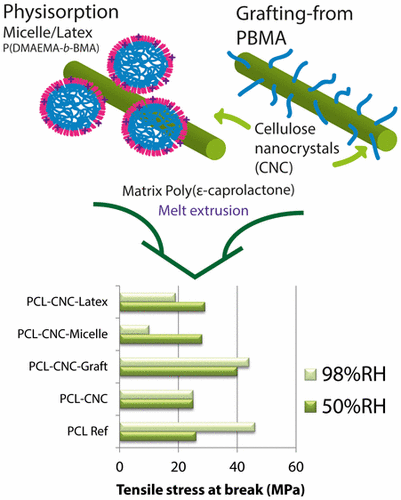当前位置:
X-MOL 学术
›
ACS Appl. Mater. Interfaces
›
论文详情
Our official English website, www.x-mol.net, welcomes your
feedback! (Note: you will need to create a separate account there.)
Polycaprolactone Nanocomposites Reinforced with Cellulose Nanocrystals Surface-Modified via Covalent Grafting or Physisorption: A Comparative Study
ACS Applied Materials & Interfaces ( IF 8.3 ) Pub Date : 2017-09-25 00:00:00 , DOI: 10.1021/acsami.7b09009 Assya Boujemaoui 1 , Carmen Cobo Sanchez 1 , Joakim Engström 1 , Carl Bruce 1 , Linda Fogelström 1 , Anna Carlmark 1 , Eva Malmström 1
ACS Applied Materials & Interfaces ( IF 8.3 ) Pub Date : 2017-09-25 00:00:00 , DOI: 10.1021/acsami.7b09009 Assya Boujemaoui 1 , Carmen Cobo Sanchez 1 , Joakim Engström 1 , Carl Bruce 1 , Linda Fogelström 1 , Anna Carlmark 1 , Eva Malmström 1
Affiliation

|
In the present work, cellulose nanocrystals (CNCs) have been surface-modified either via covalent grafting or through physisorption of poly(n-butyl methacrylate) (PBMA) and employed as reinforcement in PCL. Covalent grafting was achieved by surface-initiated atom transfer radical polymerization (SI-ATRP). Two approaches were utilized for the physisorption: using either micelles of poly(dimethyl aminoethyl methacrylate)-block-poly(n-butyl methacrylate) (PDMAEMA-b-PBMA) or latex nanoparticles of poly(dimethyl aminoethyl methacrylate-co-methacrylic acid)-block-poly(n-butyl methacrylate) (P(DMAEMA-co-MAA)-b-PBMA). Block copolymers (PDMAEMA-b-PBMA)s were obtained by ATRP and subsequently micellized. Latex nanoparticles were produced via reversible addition-fragmentation chain-transfer (RAFT) mediated surfactant-free emulsion polymerization, employing polymer-induced self-assembly (PISA) for the particle formation. For a reliable comparison, the amounts of micelles/latex particles adsorbed and the amount of polymer grafted onto the CNCs were kept similar. Two different chain lengths of PBMA were targeted, below and above the critical molecular weight for chain entanglement of PBMA (Mn,c ∼ 56 000 g mol–1). Poly(ε-caprolactone) (PCL) nanocomposites reinforced with unmodified and modified CNCs in different weight percentages (0.5, 1, and 3 wt %) were prepared via melt extrusion. The resulting composites were evaluated by UV–vis, scanning electron microscopy (SEM), thermal gravimetric analysis (TGA), and tensile testing. All materials resulted in higher transparency, greater thermal stability, and stronger mechanical properties than unfilled PCL and nanocomposites containing unmodified CNCs. The degradation temperature of PCL reinforced with grafted CNCs was higher than that of micelle-modified CNCs, and the latter was higher than that of latex-adsorbed CNCs with a long PBMA chain length. The results clearly indicate that covalent grafting is superior to physisorption with regard to thermal and mechanical properties of the final nanocomposite. This unique study is of great value for the future design of CNC-based nanocomposites with tailored properties.
中文翻译:

通过共价接枝或物理吸附改性的纤维素纳米晶体增强的聚己内酯纳米复合材料:对比研究
在本工作中,纤维素纳米晶体(CNCs)已通过共价接枝或通过聚甲基丙烯酸正丁酯(PBMA)的物理吸附进行了表面改性,并被用作PCL的增强材料。共价接枝是通过表面引发的原子转移自由基聚合(SI-ATRP)实现的。两种方法用于所述物理吸附:使用聚的任胶束(二甲基氨基乙基甲基丙烯酸酯) -嵌段-聚(Ñ丁基甲基丙烯酸酯)(PDMAEMA- b -PBMA)或聚的胶乳颗粒(二甲基氨基甲基丙烯酸酯共-甲基丙烯酸) -块-聚(ñ丁基甲基丙烯酸酯)(P(DMAEMA-共-MAA) - b-PBMA)。通过ATRP获得嵌段共聚物(PDMAEMA- b- PBMA),然后进行胶束化。胶乳纳米粒子是通过可逆的加成-断裂链转移(RAFT)介导的无表面活性剂乳液聚合生产的,采用聚合物诱导的自组装(PISA)进行粒子形成。为了进行可靠的比较,胶束/胶乳颗粒的吸附量和接枝到CNC上的聚合物的量保持相似。确定了PBMA的两种不同链长,分别低于和高于PBMA的分子缠结的临界分子量(M n, c〜56 000 g mol –1)。通过熔融挤出制备以不同重量百分比(0.5、1、3重量%)的未改性和改性CNC增强的聚(ε-己内酯)(PCL)纳米复合材料。通过紫外可见光谱,扫描电子显微镜(SEM),热重分析(TGA)和拉伸测试对所得的复合材料进行了评估。与未填充的PCL和包含未修饰CNC的纳米复合材料相比,所有材料均具有更高的透明度,更高的热稳定性和更强的机械性能。接枝CNC增强的PCL的降解温度高于胶束改性的CNC,而后者高于PBMA长链的乳胶吸附的CNC。结果清楚地表明,就最终纳米复合材料的热和机械性能而言,共价接枝优于物理吸附。
更新日期:2017-09-26
中文翻译:

通过共价接枝或物理吸附改性的纤维素纳米晶体增强的聚己内酯纳米复合材料:对比研究
在本工作中,纤维素纳米晶体(CNCs)已通过共价接枝或通过聚甲基丙烯酸正丁酯(PBMA)的物理吸附进行了表面改性,并被用作PCL的增强材料。共价接枝是通过表面引发的原子转移自由基聚合(SI-ATRP)实现的。两种方法用于所述物理吸附:使用聚的任胶束(二甲基氨基乙基甲基丙烯酸酯) -嵌段-聚(Ñ丁基甲基丙烯酸酯)(PDMAEMA- b -PBMA)或聚的胶乳颗粒(二甲基氨基甲基丙烯酸酯共-甲基丙烯酸) -块-聚(ñ丁基甲基丙烯酸酯)(P(DMAEMA-共-MAA) - b-PBMA)。通过ATRP获得嵌段共聚物(PDMAEMA- b- PBMA),然后进行胶束化。胶乳纳米粒子是通过可逆的加成-断裂链转移(RAFT)介导的无表面活性剂乳液聚合生产的,采用聚合物诱导的自组装(PISA)进行粒子形成。为了进行可靠的比较,胶束/胶乳颗粒的吸附量和接枝到CNC上的聚合物的量保持相似。确定了PBMA的两种不同链长,分别低于和高于PBMA的分子缠结的临界分子量(M n, c〜56 000 g mol –1)。通过熔融挤出制备以不同重量百分比(0.5、1、3重量%)的未改性和改性CNC增强的聚(ε-己内酯)(PCL)纳米复合材料。通过紫外可见光谱,扫描电子显微镜(SEM),热重分析(TGA)和拉伸测试对所得的复合材料进行了评估。与未填充的PCL和包含未修饰CNC的纳米复合材料相比,所有材料均具有更高的透明度,更高的热稳定性和更强的机械性能。接枝CNC增强的PCL的降解温度高于胶束改性的CNC,而后者高于PBMA长链的乳胶吸附的CNC。结果清楚地表明,就最终纳米复合材料的热和机械性能而言,共价接枝优于物理吸附。











































 京公网安备 11010802027423号
京公网安备 11010802027423号